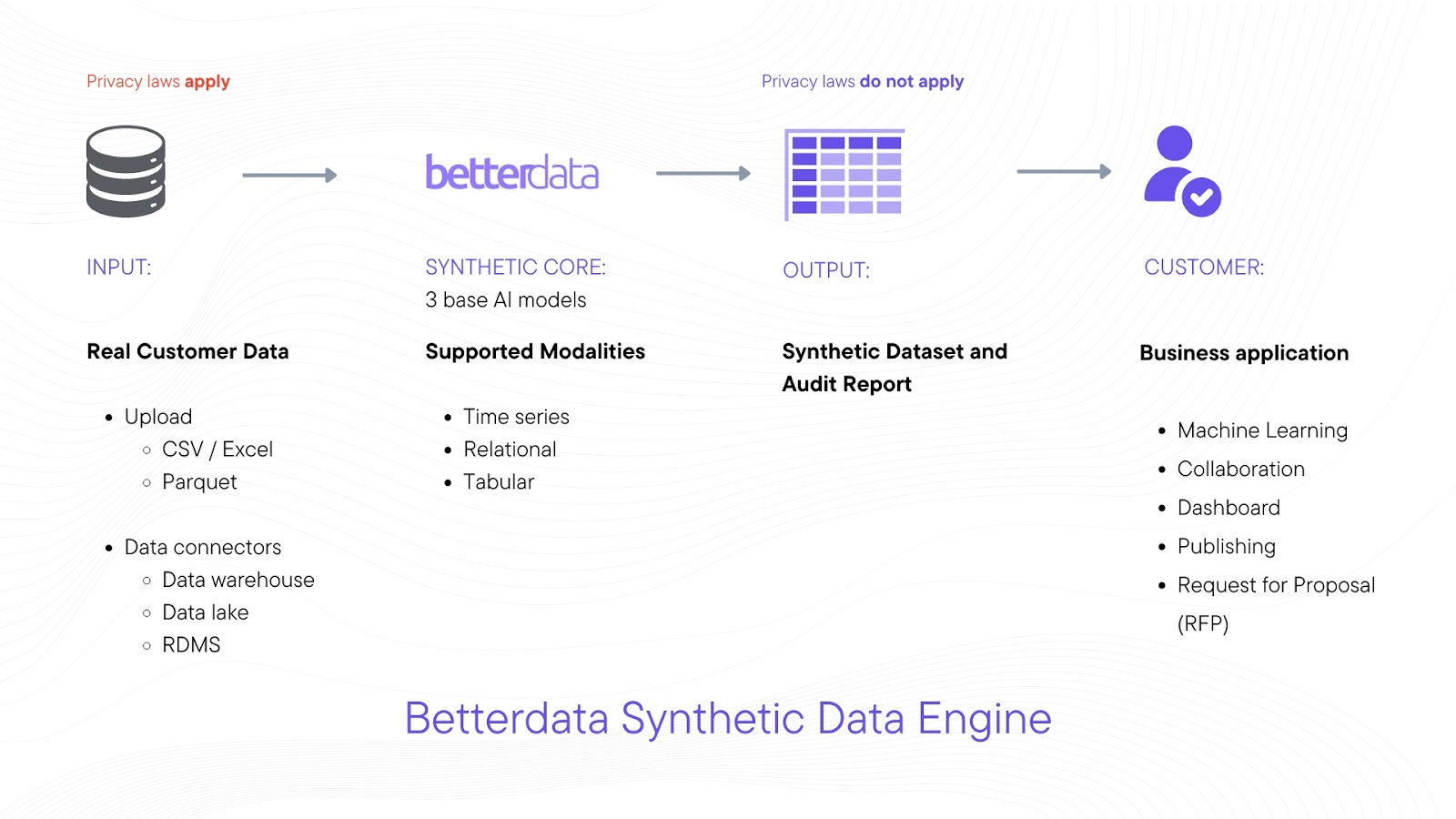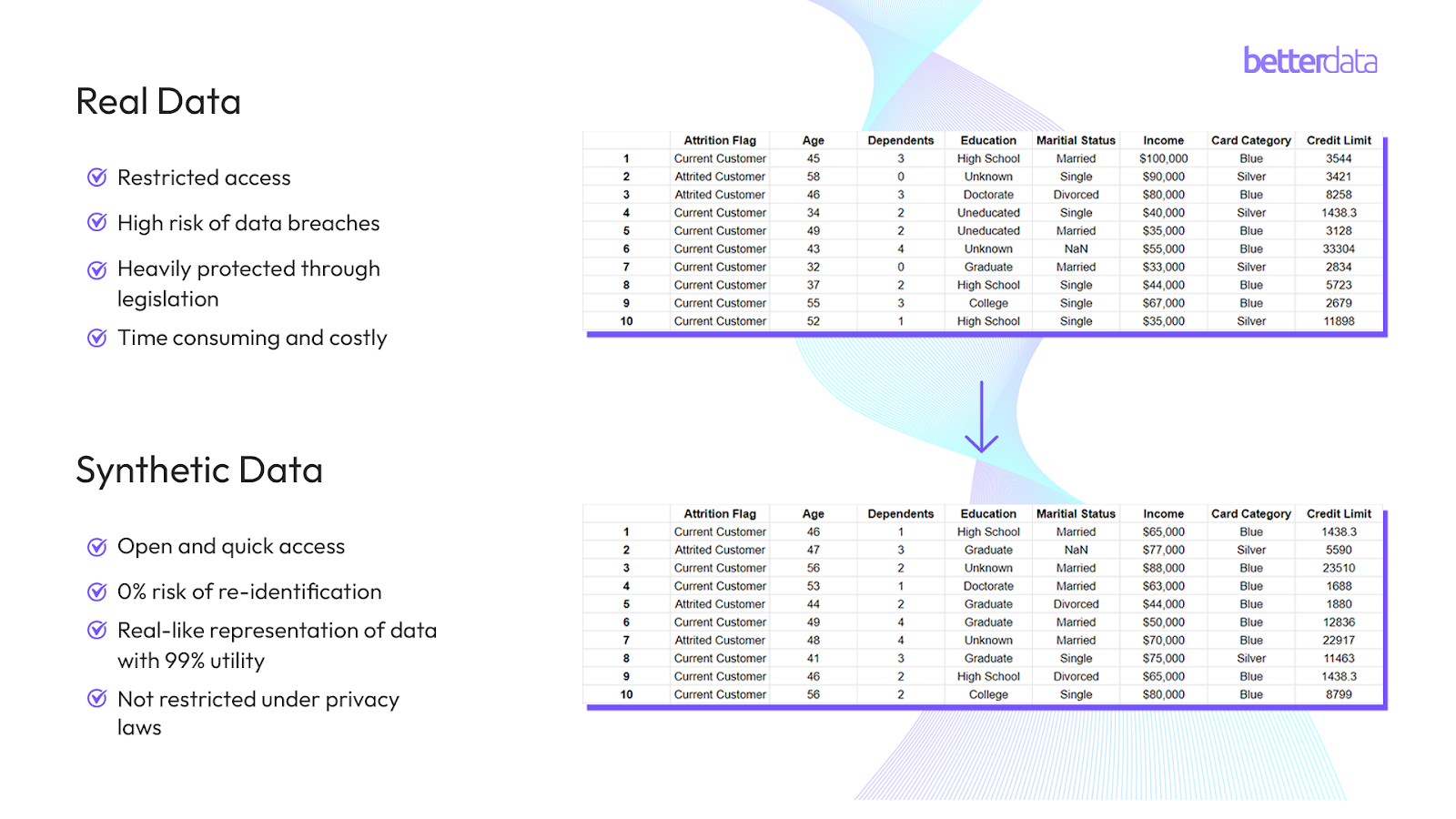1. What is Synthetic Data?
Simply put, synthetic data is the future of artificial intelligence, machine learning, data privacy , and business growth.
In technical terms, Synthetic data is artificially generated data that simulates real-world data through the use of sophisticated algorithms and statistical models. This type of data is created by applying techniques such as generative adversarial networks (GANs), variational autoencoders (VAEs), and other machine-learning methodologies. These methods are designed to capture and replicate the underlying characteristics, patterns, and statistical distributions present in the actual dataset.
To summarize,
- Synthetic data is fake data that mimics the statistical properties and behavior of real data.
- It is a subset of GenAI and is created through advanced and sophisticated machine learning models.
- It does not contain any information about any real individuals hence is generally not liable to any data privacy laws.

2. Data Privacy and Protection cannot be ignored anymore!
As per research by PWC, 85% of customers say that they are unwilling to do business with a firm if it does not prioritize data privacy. There it is. The consumer is now not the trusting and loyal individual it once was. Consumers have now become tech-savvy and they have come to understand that their data is now more at risk of ending up in the wrong place ever in recorded history.
a. Legal Compliance:
With public backlash for strict data privacy laws and with the sudden boom in AI development in the past 2 years, governments are now placing more data privacy laws, and organizations that do not adhere to these laws are placed under intense scrutiny. Regulations like GDPR (European Union), CCPA (California), HIPAA (USA), PDPC (Singapore), and other organizations globally mandate strict data privacy and protection standards.
The annual costs of data breaches globally are predicted to exceed $5 trillion in 2024, showing a significant 11% y.o.y growth since 2019. A major contributing factor to this growth is the increase in data privacy and protection legislation resulting in more and larger fines.
b. Consumer Trust:
While many might think that data breaches do not impact the brand as much as it does the business, think again. As per research:
- 75% of consumers are willing to cut ties with the brand after a cyber security attack.
- 66% of consumers did not trust a brand that has a data breach.
- 44% of consumers think that the cyber security attack is caused by the brand’s lack of appropriate data security measures.
As we have talked about earlier, consumers are becoming data-conscious. And why wouldn’t they be? Their lives are now digital. Data about their work, social life, finances, travel, household, search history, etc is stored somewhere on a server or on a cloud network. This is information that can be used to influence their decision-making through targeted ads, change their behavior through suggested lifestyle blogs, suggest who to go on a date with, and in more sinister ways blackmail them, hack into their personal accounts, create false identities, set up credit cards, and a whole lot more. Consumers know that and still they click accept to cookies, and terms and conditions. This is done with the sense of trust that the brand is going to protect their data. Once that trust is gone, so does the consumer spend attached to it.
3. How Synthetic Data Ensures Data Privacy:
a. Elimination of PII:
Synthetic data ensures data privacy by eliminating personally identifiable information (PII). Through advanced algorithms, synthetic datasets are generated to mimic the statistical properties of real data without including any actual PII. This means that the data retains its utility for analysis, modeling, and decision-making while completely removing the risk of exposing sensitive personal information. Consequently, organizations can confidently use and share synthetic data without worrying about privacy breaches or compliance violations.
b. Modern Data Anonymization:
Synthetic data serves as a powerful modern anonymization technique. Unlike legacy data anonymization methods that often struggle to fully obscure individual identities, synthetic data is inherently anonymized. The synthetic data generation process ensures that there is no direct link back to any real individuals, making it impossible to trace any data point to its origin. This built-in anonymization aligns with stringent privacy regulations like PDPA, GDPR, and CCPA, thereby mitigating legal risks and safeguarding against potential privacy violations.
c. Enhanced Security:
The use of synthetic data significantly enhances data security. Since synthetic data is generated to resemble real data without containing actual user information, the consequences of a data breach are greatly reduced. In scenarios where synthetic data is used for testing, training, and development, there is no risk of compromising real user data. This secure environment allows organizations to innovate and develop robust solutions without the looming threat of data leaks or breaches affecting real individuals.
d. Controlled Data Sharing:
Synthetic data facilitates controlled and secure data sharing. Organizations can share synthetic datasets with partners, vendors, and other third parties without exposing any sensitive information. This enables seamless collaboration and innovation while maintaining high standards of data privacy. The ability to share data freely without the risk of violating privacy regulations fosters a more open and productive ecosystem, driving advancements across various industries.
e. Bias Mitigation:
One of the key benefits of synthetic data is its ability to mitigate bias in datasets improving machine learning models. By generating balanced and diverse synthetic data, organizations can address and reduce biases inherent in real-world data. This ensures that machine learning models and analytical insights derived from the data are fair and unbiased. The result is more accurate, equitable, and reliable outcomes, which are crucial for making informed and just decisions in business, healthcare, finance, and beyond.

4. Conclusion:
Synthetic data is a big step forward in protecting data privacy which is why Gartner predicts that synthetic data will 100% replace real data in machine learning by 2030. By removing the risk tied to real-world data, it offers a safe, compliant, and efficient method to use data across various applications. As artificial intelligence progresses, synthetic data will become even more crucial, ensuring privacy while driving innovation and growth in multiple industries. It's a powerful tool that not only protects individual privacy but also opens up new possibilities for businesses to thrive without the constant worry of data breaches or legal issues.Imagine this. You work for a Fortune 500 company. You are launching a new business vertical, or adding a new product feature, or you want to analyze what user behavior has been for the past 6 months and what it will be in the next 6 months. Now think of how hard and time-consuming it is going to be. If your answer is it will take up to 6 months to collect, clean, and anonymize data to be able to use it. This blog is for you. Data is gold. We have all heard it and we disagree. Data is the forbidden fruit. It’s there for the taking, everyone wants it yet many don’t and the ones that do are heavily fined. And before you say ‘Oh but, we use data daily.’ We are not talking about suppressed or encrypted data that yields little to no value in today's world but about true data with 100% utility and no red tape about data privacy laws. And yes it’s possible. With AI everything is possible. And this is exactly what we will be talking about in this article.




